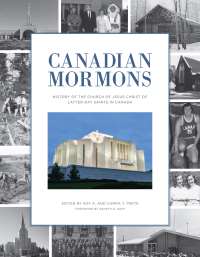Conclusions and Reflections
Roy A. Prete
Roy A. Prete, “Conclusions and Reflections,” in Canadian Mormons: History of the Church of Jesus Christ of Latter-Day Saints in Canada, ed. Roy A. and Carma T. Prete (Provo, UT: Religious Studies Center; Salt Lake City: Deseret Book, 2017), 566-576.
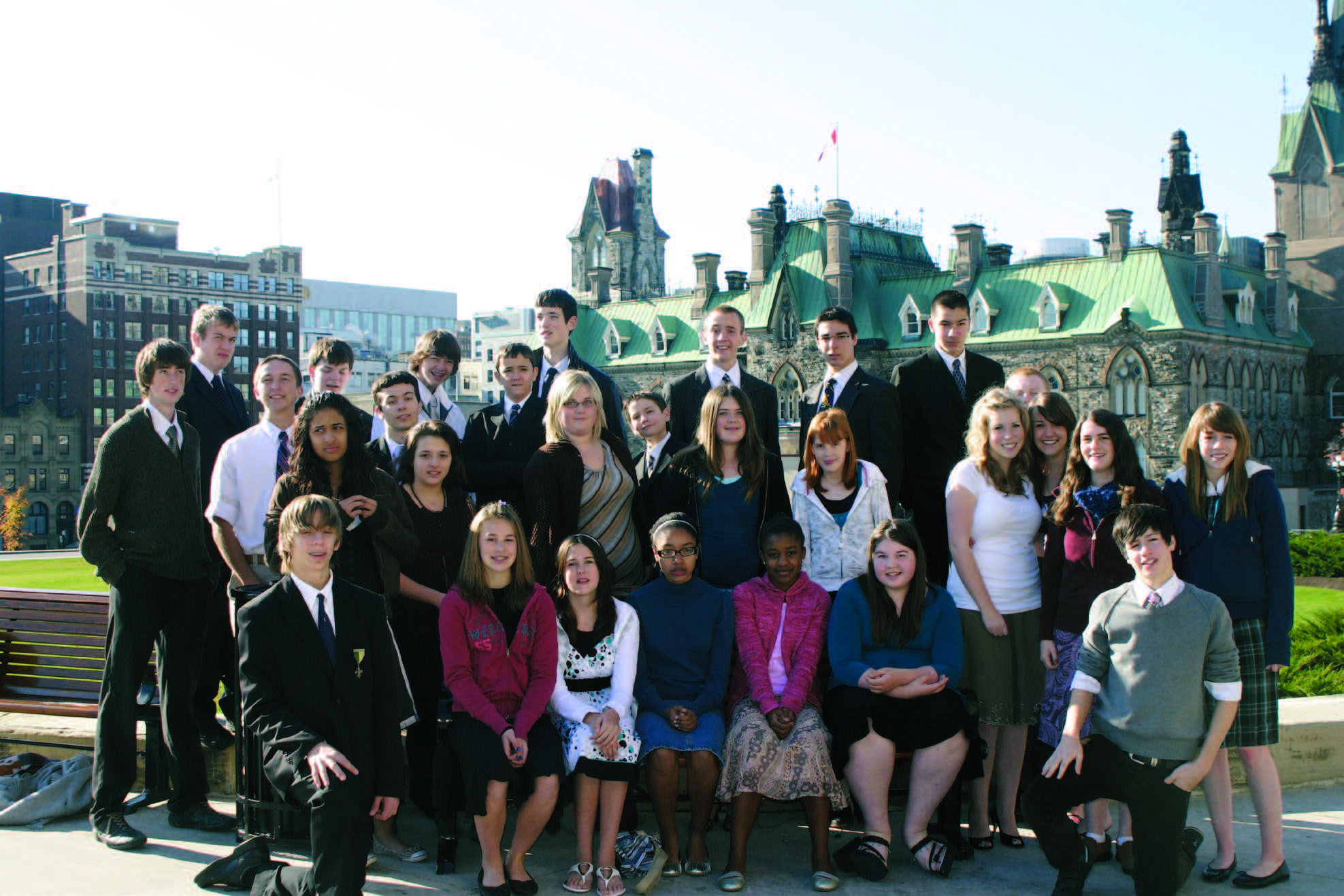 These enthusiastic Latter-day Saint youth, standing with the Canadian Parliament Building in the background, are symbolic of the Church in Canada. Canadian Mormons are loyal and responsible citizens who contribute to making Canada a better place for all. The rising generation is key to the continued growth and future development of the Church in Canada. (IRI)
These enthusiastic Latter-day Saint youth, standing with the Canadian Parliament Building in the background, are symbolic of the Church in Canada. Canadian Mormons are loyal and responsible citizens who contribute to making Canada a better place for all. The rising generation is key to the continued growth and future development of the Church in Canada. (IRI)
A conclusion is essentially a conversation about a piece of written work and a reflection on its meaning. As editor, if I had a conversation with someone who had just finished reading a book such as this, my first question would probably be, “How did you like the book?” After some discussion on the highlights (and perhaps deficiencies) of the book, the reader—in this case assumed to be a Latter-day Saint—would probably want to know, “What does it all mean?” This could lead to a discussion on the relationship between past, present, and future and what the book might contribute to a better understanding of who we are as Canadian Latter-day Saints and how we can better communicate a cherished heritage to the rising generation.
While there are many possible models for the writing of academic history on religious topics, the editors of this book have not chosen to write a detached third-person account, but rather to tell the story from the point of view of those who lived it. Nor have they shied away from trying to present the material, though based on very thorough research, in the format of an illustrated book with many anecdotal sidebars, numerous photos, and a variety of maps, timelines, and graphs to help the reader wend his or her way through a very complicated story with many names and places. We hope you like the formula and that you have felt edified as you have explored the intricacies of the tale of a religious people and their struggles to live their religion and establish “Zion” in a beloved country which they call home.
Nor have the editors been afraid to approach the topic from the point of view of what this incredible tale of faith, dedication, perseverance, and mutual support has to do with current issues and our preparation for the future. They cherish and take direction from the prophetic wisdom of President Thomas S. Monson that we should “learn from the past,” “live in the present,” and “prepare for the future.”[1]
What are the insights to be garnered and the lessons learned from the history of The Church of Jesus Christ of Latter-day Saints in Canada? How can awareness of this faith heritage contribute to the reinforcement of our immediate faith journey and that of those whom we love and for whom we have a stewardship? And finally, how can this book help us prepare for the future, which will undoubtedly be fraught with challenges both on an individual and collective level?
Learn from the Past
There are several insights to be garnered from the book that are worthy of our reflection. It should be recalled that the history of The Church of Jesus Christ of Latter-day Saints in Canada is part of a broader story, that of the history of the Church in the United States and worldwide. Because of the close proximity of Canada to the United States, Canada has been involved in nearly every phase of the broader story.
In the early period, from shortly after the organization of the Church in 1830 until the mid-1850s, missionaries came to Canada to preach the message of the Restoration of the gospel: that God had called a modern-day prophet, that the church of Jesus Christ was again upon the earth, and that God had provided a companion book of scripture to the Bible, the Book of Mormon, as another witness of Christ. In a pioneer era in which there was considerable discussion, even controversy, on the subject of religion, many people were attracted to this fledgling religion. Some 2,500 converts from eastern Canada, mostly from Upper Canada, now known as Ontario, swelled the ranks of the Church and hearkened to the counsel to gather with the Saints. The bulk of these went west to Utah with Mormon pioneers under Brigham Young after the martyrdom of Joseph Smith in 1844.
Included among those were such notables as John Taylor, a Toronto convert, who later became the third President of the Church (1877–87); Marriner W. Merrill, from New Brunswick, who later became an Apostle (1889–1906); and Ira Nathaniel Hinckley, from Upper Canada, grandfather of President Gordon B. Hinckley. Canadian Saints swelled the ranks of the early Church, founded settlements in Utah, and provided both Church and civic leaders. Canadian converts were instrumental in spreading the gospel to England and to Scotland. This early history of the Church experience in Canada is an inspiring heritage for the benefit of all believing Canadian Latter-day Saints and part of a story of broader interest to those in the Church who have Canadian ancestors. It is in fact a significant aspect in the broader topic of Canadian-American history.
A generation later, at a time when the Latter-day Saints were persecuted for their practice of polygamy, Charles Ora Card led a group of forty-one stalwart pioneers from Cache Valley, Utah, to Lee Creek (later Cardston), Alberta, in 1887. Card’s little group was followed by others who made a second long journey—this time north rather than west—for the establishment of their faith. Toward the turn of the century, another group came, some as the result of mission calls, to build canals and settle in the Magrath and Stirling areas, while yet another group came to grow sugar beets and found the town of Raymond. These waves of settlers laid the foundation for a solidly Latter-day Saint settlement in southern Alberta. The crowning joy of this early group, now numbering nearly ten thousand, was the dedication of the Cardston Alberta Temple in 1923, the first beyond the jurisdiction of the United States. The temple symbolized the permanent establishment of the Latter-day Saints in Canada, the culmination of their highest aspiration, in which the ordinances of salvation could be administered locally. The temple has been a beacon of light ever since to the people of southern Alberta and all across Canada. It has provided a place of gathering against the storms of the world and has been a key factor in the creation of intergenerational families, in which the southern Alberta community has been so successful.
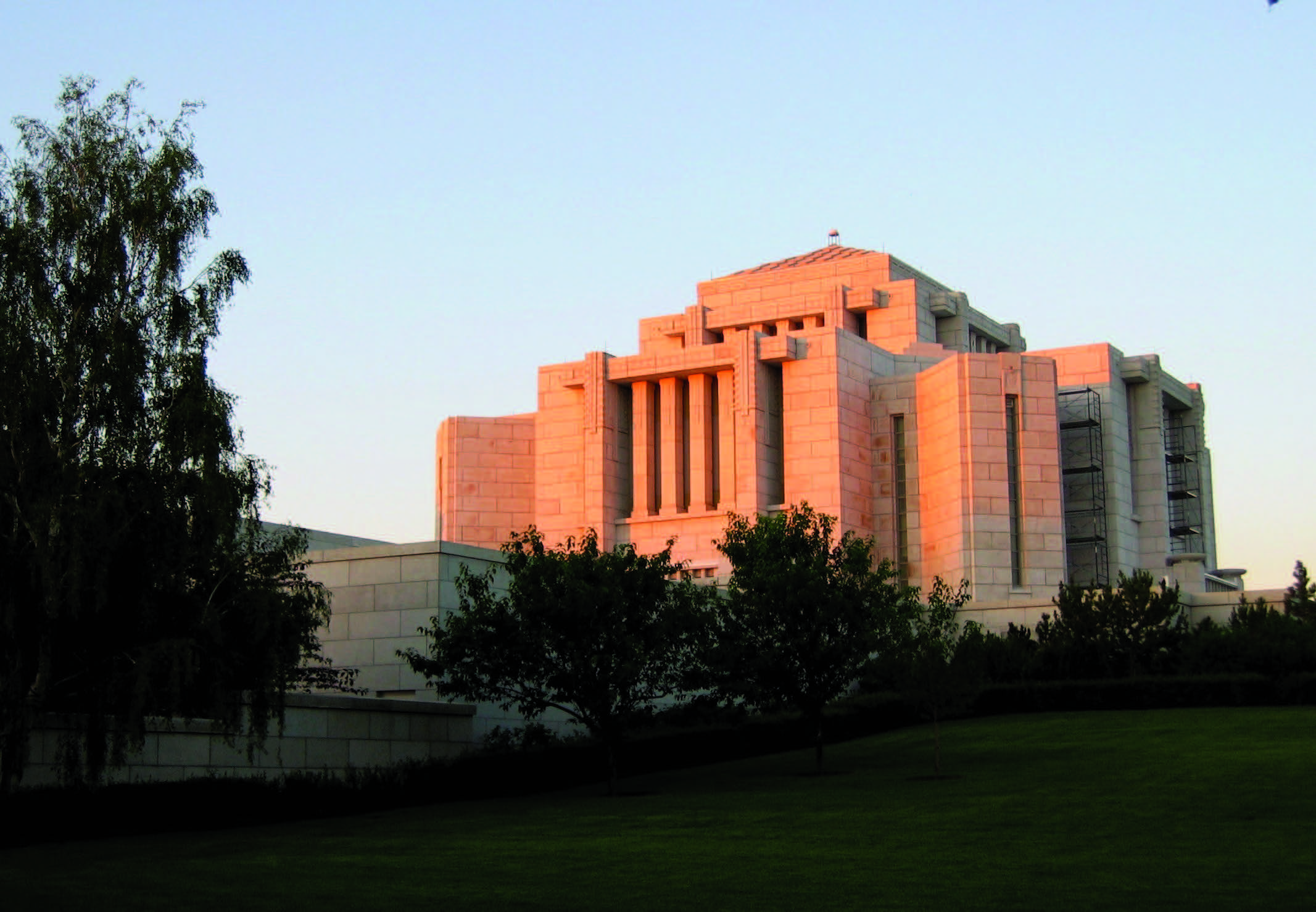 The Cardston Alberta Temple, dedicated in 1923, has long been a symbol of permanence and spiritual strength to Church members in Canada. (Lynn Rosenvall)
The Cardston Alberta Temple, dedicated in 1923, has long been a symbol of permanence and spiritual strength to Church members in Canada. (Lynn Rosenvall)
No one can read about the drama of the establishment of The Church of Jesus Christ of Latter-day Saints all across Canada in the twentieth century without being moved by the faith, dedication, and endurance of early pioneers in each area. At the end of 2016, there were 486 congregations in forty-eight stakes and three districts and 193,850 members in Canada, making the Church an essential part of the Canadian religious landscape. That remarkable achievement, like those of earlier days, is a testament to the faith, dedication, and united effort of many people over a long period, whose stories are an inspiration to successive generations of Latter-day Saints.
The establishment of the Church in the many areas across Canada outside the Alberta settlement followed a consistent pattern. Most growth resulted from missionary work. Faithful missionaries either converted one or more stalwart families or located member families in each location who had moved in from southern Alberta or elsewhere, and began to hold meetings in homes. When more converts were added, they met in rented halls, from which beer bottles and cigarette butts had to be removed and the building aired out before Sunday meetings could be held. In due course, when the congregation became larger, either a local church building was purchased or another facility renovated. In due course, an approved LDS chapel was built. This pattern was repeated many times and in many places, as Church congregations became established all across the country. Certainly, our children, grandchildren, and other generations to follow will be motivated by this remarkable example of missionary work and its power to save souls. Many of the stories of these early pioneers will be personal to those who live in the areas where they took place.
Those reading the book will be informed and perhaps enlightened by the broad strokes of the unfolding saga of Church development. They will be interested to know that the first location to receive missionaries at the end of the nineteenth century was Manitoba, to which missionaries came sporadically after 1875, followed by Ontario in the 1890s. They will perhaps be surprised to know that the Winnipeg Branch, formed in 1909, was the first branch of the Church formed outside of Alberta and had its own building by 1914. The formation in 1919 of the Canadian Mission, covering all of Canada east of Saskatchewan, laid the foundation for the establishment of the Church in eastern Canada. The formation of the Western Canadian Mission in 1941 provided the vehicle for the extension of missionary work in western Canada. The thousands of missionaries who have served in Canada deserve our special recognition as do the thousands from Canada who have served in other lands all over the world.
 Hugh B. Brown, the first president of the Lethbridge Stake, later became an Apostle and a member of the First Presidency. His wife, Zina, was the daughter of Charles Ora Card. (LeRoy Rollins)
Hugh B. Brown, the first president of the Lethbridge Stake, later became an Apostle and a member of the First Presidency. His wife, Zina, was the daughter of Charles Ora Card. (LeRoy Rollins)
The Alberta story may be familiar to many, but it is well worth remembering. In Alberta, Church expansion followed the migration of Saints from southern Alberta progressively to locations further north, which, with the addition of new converts and other move-ins, resulted in the formation of the Lethbridge Stake (1921), the Calgary Stake (1953), the Edmonton Stake (1960), the Red Deer Stake (1982), and the Grande Prairie Stake (1998). Despite rural depopulation, southern Alberta (expanded to ten stakes) has remained a vibrant part of the Alberta religious landscape and continues to be a source of leadership for many parts of the country. The grand gathering places have been the cities in Alberta where people have come for economic reasons, to benefit from strong Church programs, and (before the building of temples in other locations) to be closer to the temple. Lethbridge in 2016 had three stakes, Edmonton had four, and Calgary had seven. The southern Alberta pioneer heritage has remained strong throughout Alberta. With the rapid growth of the Church across Canada, the percentage of Latter-day Saints living in Alberta declined from 53 percent in 1965 to 42 percent in 2015.[2] But with twenty-three of the forty-eight stakes in Canada, Alberta nonetheless remains a powerhouse of Latter-day Saint strength in Canada.
Many will know that the first stakes outside of Alberta were formed in 1960 in Vancouver and Toronto. But many may not be fully aware that during the mid-1970s, the Church strengthened its missionary focus in Canada by creating new missions in Montreal (1972), Halifax (1973), Vancouver (1974), and Winnipeg (1976). Strong Church growth from the 1950s through to the early 1990s (5 percent per year from 1956 to 1990) resulted in the creation of new stakes all across the country. In the twelve-year period from 1974 to 1985, twenty-one new stakes were created (nearly half of the current forty-eight), with others added later. Of note are the two French-speaking stakes in Quebec formed as a result of proselytizing among the French-speaking population begun in the early 1960s. While some stakes are very large in terms of area—the Manitoba stake, for example, covers the whole province—nearly all of Canada is now within the boundaries of a stake of Zion, with the spiritual protection that affords against current and future evils (see D&C 115:6). With the growth of the Church and its wide dispersion across the country, new centres of strength have emerged, such as Ontario, which has nine stakes and two districts, and British Columbia, with eight stakes and a district.
While the Alberta settlement story and the development of the Church across the entire country may appear as separate stories, it is apparent that in God’s grand design they have been part of a single integrated program for the establishment of the Church in Canada. Like Utah in the United States, southern Alberta has been a place for the gathering of the Saints, especially since the dedication of the Cardston Alberta Temple in 1923. But as in Utah, when land resources became insufficient for the growing population, southern Alberta witnessed the dispersion of Latter-day Saints to other areas, largely for economic and educational opportunities. This was especially true in the post–World War II era, in which southern Albertans not only moved northward in Alberta in large numbers but also fanned out to other Canadian cities in which they were able to provide seasoned leadership in developing congregations. Considered from this point of view, the period since 1887 may be seen as a single integrated period in which the Church in Canada benefited at different times and in varying degrees from both settlement and proselytizing.
The next phase in the maturing development of the Church across Canada was the building of temples to make the sacred temple ordinances more readily available to the expanding membership. The Toronto Ontario Temple, a fairly large temple, was dedicated in 1990. As part of the program instituted by President Gordon B. Hinckley in 1997 to build smaller temples more readily accessible to the people, four smaller temples were built in Regina (1999), Halifax (1999), Edmonton (1999), and Montreal (2000), with groundbreaking for a fifth in Winnipeg in late 2016. Larger temples were built in Vancouver (2010) and Calgary (2012). These temples signified the permanent establishment of the Church in Canada and the growing spiritual maturity of the members in each area.
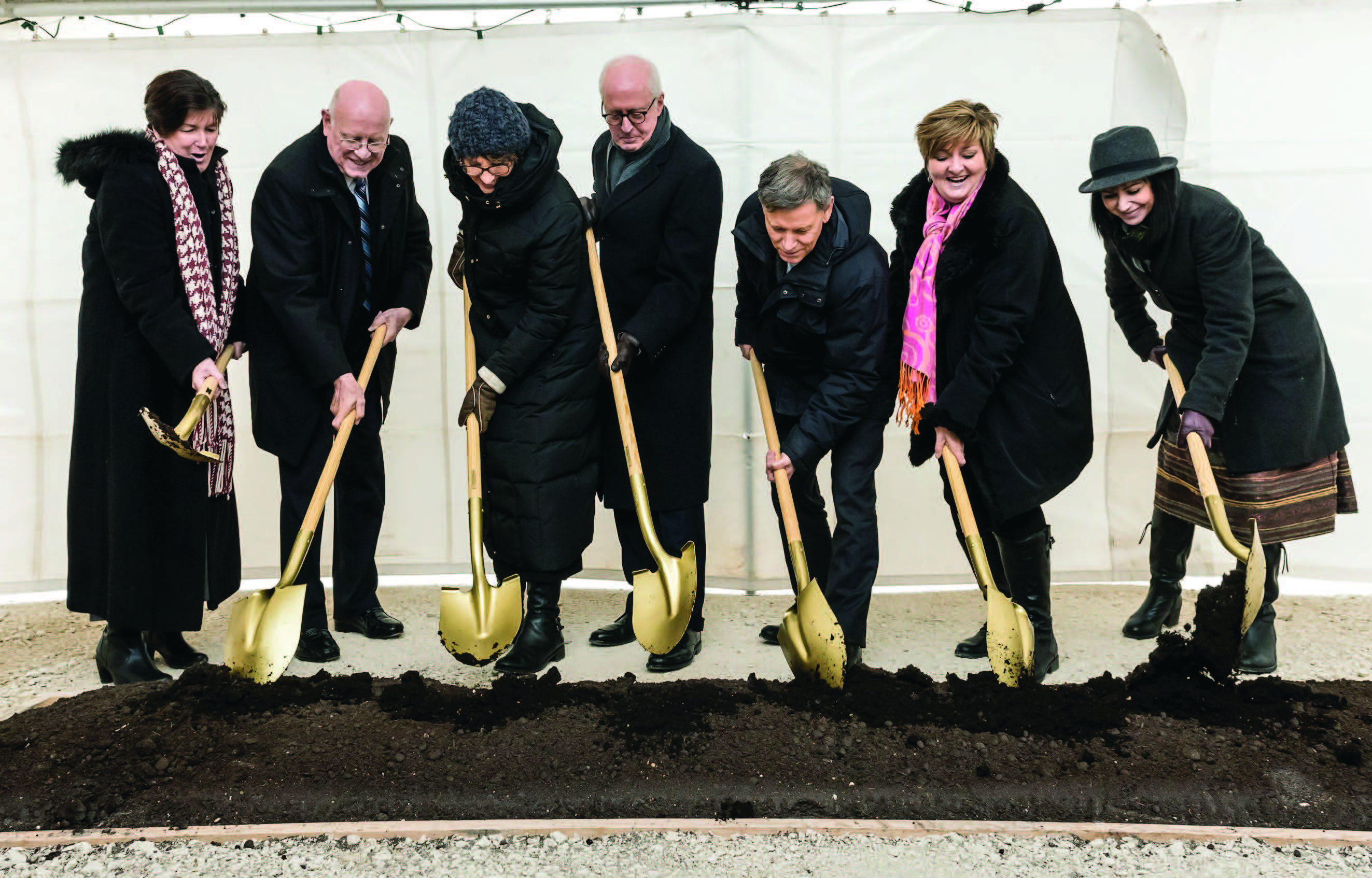 Ground was broken in December 2016 for the Winnipeg Manitoba Temple. Left to right, Yvonne and Allan Robison, former stake president; Lynda and Elder Larry Y. Wilson, Executive Director of the Temple Department; Terry Duguid, Member of Parliament, Winnipeg South; Janice Lukes, counselor for South Winnipeg, St. Norbert Ward; and Belle Jarniewski, president of Manitoba Multifaith Council. When completed and dedicated, it will be the ninth temple in Canada.
Ground was broken in December 2016 for the Winnipeg Manitoba Temple. Left to right, Yvonne and Allan Robison, former stake president; Lynda and Elder Larry Y. Wilson, Executive Director of the Temple Department; Terry Duguid, Member of Parliament, Winnipeg South; Janice Lukes, counselor for South Winnipeg, St. Norbert Ward; and Belle Jarniewski, president of Manitoba Multifaith Council. When completed and dedicated, it will be the ninth temple in Canada.
The building of temples all across the land comes at a time when the expansion of the Church has slowed in the United States and Canada (for the period 1991 to 2015, just under 2 percent in the United States, 1.7 percent in Canada). The long-term decline in religiosity and the breakdown of traditional family values, observed in both countries, may be important factors in this decline. Having ready access to temple ordinances is surely a bastion against the current erosion of family values and, as in the case of the Cardston Alberta Temple, will assist in the ultimate goal of creating intergenerational families and serve as a place of gathering.
The remarkable history of the Latter-day Saints in Canada in each phase of its development has relied on the faith and dedication of missionaries and members working together to build the Church. Indeed, the history of the Church in Canada could be greatly enriched by a history written from the point of view of the missions and missionary work. The Church has also been built up by the service and dedication of Church members and leaders, all of whom have functioned on a voluntary basis and without financial remuneration. These are the unsung heroes, the pioneer Saints of every generation who have quietly gone about living their religion, rendering service to their fellow men and nurturing their families. The faithful payment of tithes and offerings has been the hallmark of their commitment and has allowed the Church to house each congregation in attractive, functional meetinghouses all across the country and to provide necessary Church programs.
Among those who have served are some who have cast a long shadow, such as Charles Ora Card, who founded the Alberta settlement, and Edward James Wood, who served as stake president of the first stake in Alberta for thirty-nine years and concurrently for nineteen years as president of the Cardston Alberta Temple. Hugh B. Brown, the first president of the Lethbridge Stake, was called as an Apostle in 1958 and later served for seven years with a fellow Canadian, Nathan Eldon Tanner, as a counselor to President David O. McKay. Nathan Eldon Tanner served thirteen years as president of the Edmonton Branch, seven years as president of the Calgary Stake, and, called to the apostleship in 1962, served nineteen years as counselor in the First Presidency under four Church Presidents. The influence of these remarkable leaders is still felt today.
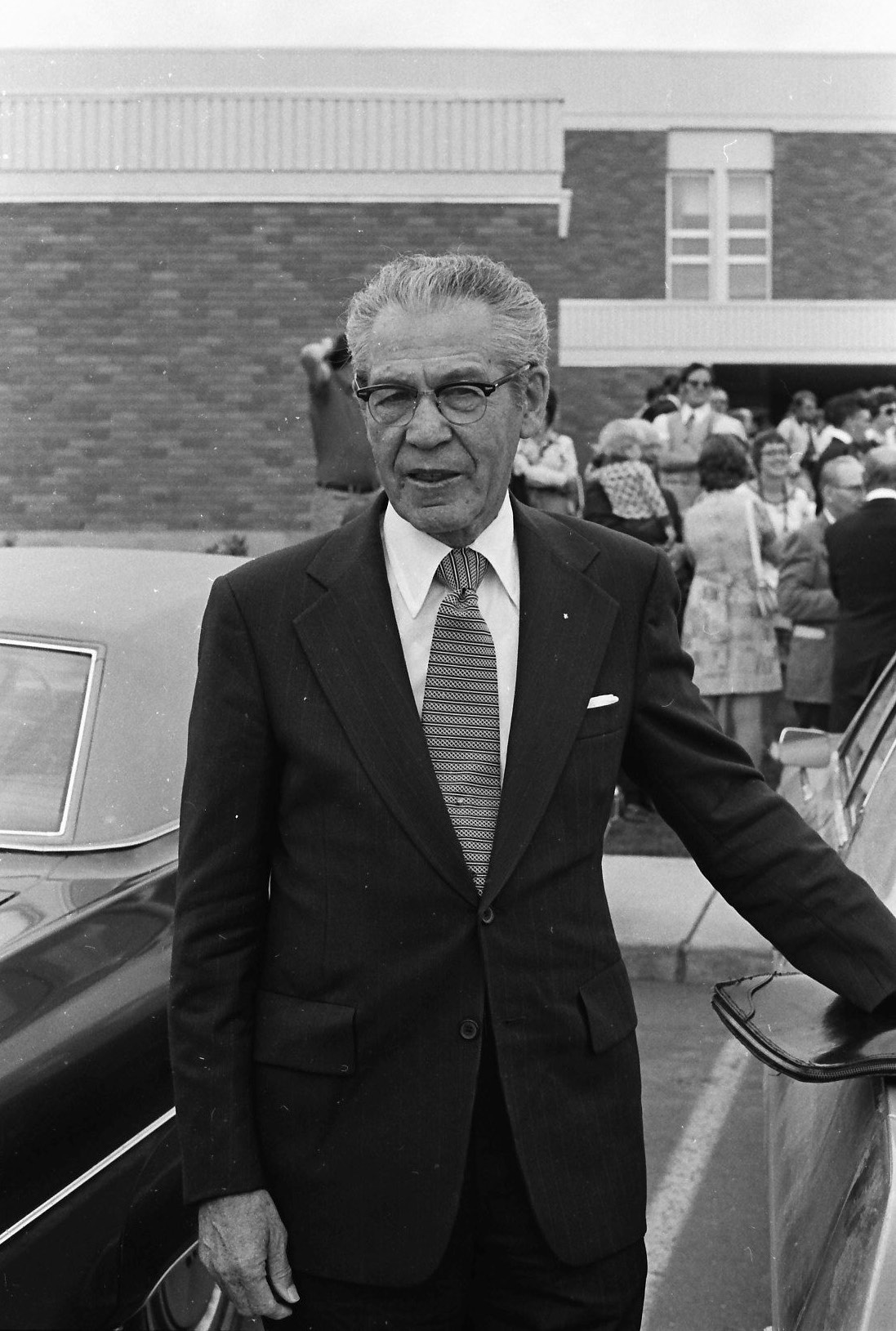 Nathan Eldon Tanner, a leader well known and beloved by the Canadian Saints, attended a solemn assembly held in Calgary in 1975. He was at that time a counselor to Church President Spencer W. Kimball. (Walter Meyer)
Nathan Eldon Tanner, a leader well known and beloved by the Canadian Saints, attended a solemn assembly held in Calgary in 1975. He was at that time a counselor to Church President Spencer W. Kimball. (Walter Meyer)
Although not a Canadian, Thomas S. Monson had a tremendous impact as president of the Canadian Mission (1959–62), during which time he boosted missionary work, prepared members and leaders for the creation of the Toronto Stake, and began proselytizing in French-speaking Quebec. As an Apostle and counselor in the First Presidency and later Church President, he has made frequent trips back to Ontario and Quebec on special occasions, cheering the Saints and teaching them to better live the gospel.
While the centralized nature of Church governance has provided for the uniformity of forms of worship, doctrine, and the administration of ordinances, the Church in Canada has faced uniquely Canadian challenges and has taken on a distinctive Canadian complexion as it has functioned in a Canadian environment. The challenges experienced in almost all regions of Canada have been related to the immensity of the country and the vast distances which have separated scattered members and also congregations in widely separated cities. Travel has been immense in many locations outside the major cities. Only in more recent times have electronic communications provided partial relief. Another challenge has been the weather. Apart from the west coast and to a lesser extent in the Great Lakes and Atlantic regions, Canada is a very cold country, and cold and unpredictable weather has been a serious challenge, making travel hazardous in winter months. Hardy Saints have nevertheless made significant sacrifices for travel, sometimes in inclement weather, to congregate and administer the programs of the Church. Faced with similar trials, the current generations and generations to come can surely take courage from the faithful service of their forebears under adverse conditions.
While southern Alberta may be viewed as an extension of the Utah Mormon heartland and, in the early days of Alberta Mormon settlement, reflected to a large degree the culture and social organization of the parent society, areas outside southern Alberta have developed their own culture and focus resulting from their convert origins and the differing needs of building up the Church in a mission field environment. Such things as dramatic presentations, rodeos, and festive celebrations, so common to southern Alberta, have found little echo in other places, and basketball, while generally a common sports event, has much less ardour elsewhere. Chocolate making, a distinctly Canadian fund-raiser, was widespread until fund-raising was no longer required in the 1990s, and outdoor nativity pageants, which spread from a Calgary presentation begun in 1962, have continued across the country. In recent times, reflecting the Churchwide emphasis on service, an all-Canadian culture has developed around community service projects, such as food drives and disaster relief. These examples help us as Canadian Latter-day Saints to reinforce a culture of personal development and service as part of our daily lives.
Latter-day Saints still have a residual affinity for First Nations people, who in the Book of Mormon are promised the blessing of the gospel in the latter days. When Charles Ora Card chose Cardston as the location for his settlement, he had an eye on the possibility of sharing the restored gospel with the native population in the nearby Kainai reserve. With varying degrees of success, Latter-day Saints have attempted to spread the gospel to the First Nations people of Canada, with notable success in the 1960s and 1970s with Crees in the Regina area. Some of these local units have been consolidated or integrated with other units, but First Nations people have continued to be a valued part of the Church.
As Canadians, we are fully aware of the bilingual nature of the country, with English and French being official languages, and with its rich multicultural mosaic. As a result of developments over the last half century, Church membership has come to reflect the linguistic and ethnic composition of Canada. While proselytizing in Quebec among the French-speaking population was delayed until the early 1960s, after the Quiet Revolution many people have since rallied to the standard of the restored gospel so that in 2015 there were two French-speaking stakes in Quebec. Likewise, since the 1960s, Canadian government immigration policy has given rise, particularly in the major cities, to a large multicultural population, composed of people from many countries. Where sufficient numbers have existed, branches and wards of the Church have been organized for each linguistic group so that there are now Spanish, Mandarin, and Korean units in places such as Vancouver, Calgary, Toronto, and Montreal. Other wards in the big cities have a commingling of a multitude of ethnic groups, which adds a rich cultural diversity. The unique ethnic composition of Canada is thus mirrored in the Latter-day Saint population, although the proportions, as various authors have pointed out, varys somewhat. All this is a constant reminder for us as Canadians to continue to be tolerant of our neighbours, whatever their ethnic origin, politics, or religions.
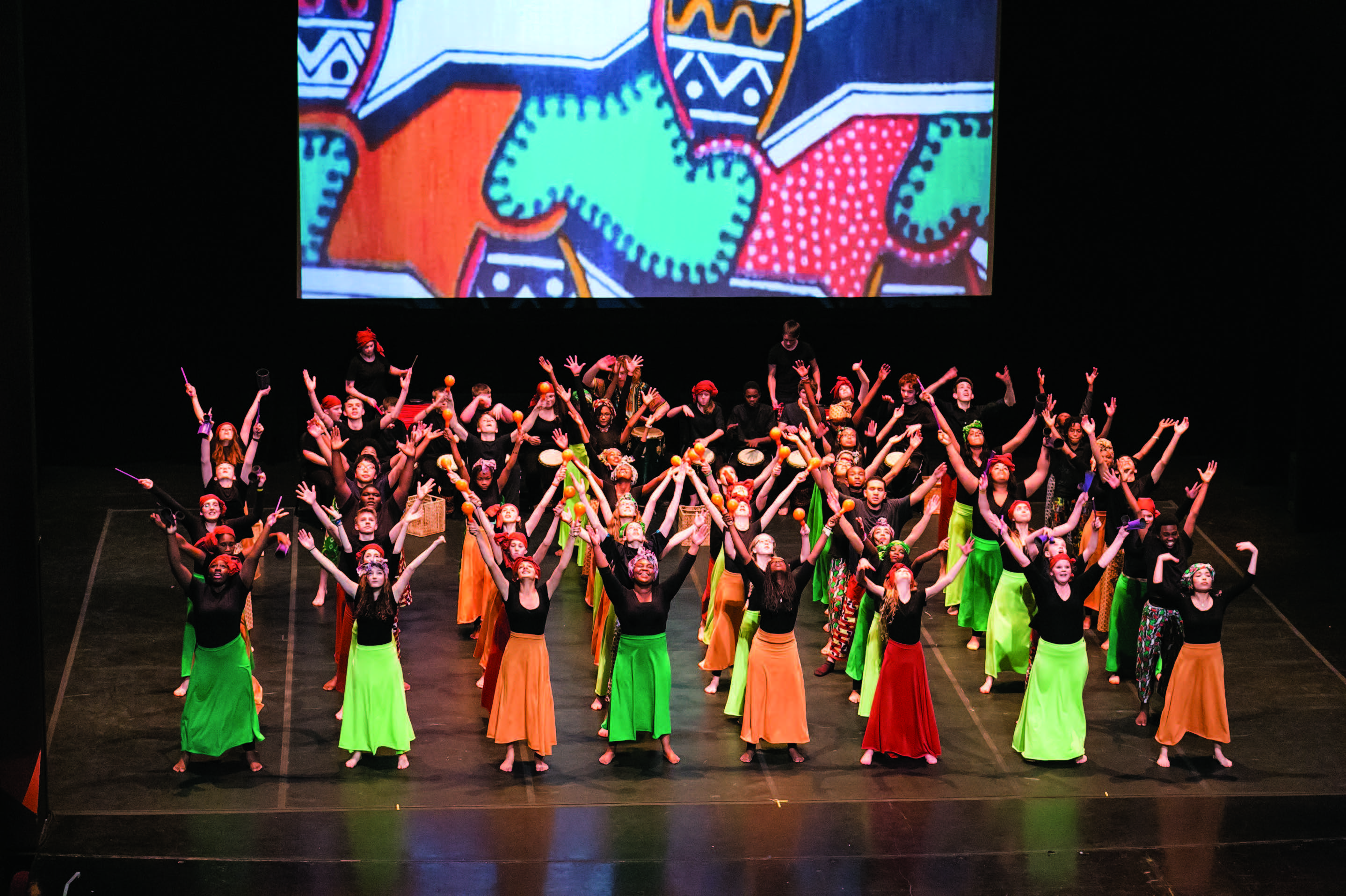 The youth cultural celebration prior to the rededication of the Montreal Quebec Temple in 2015 illustrates the multicultural nature of the Church in Canada. (Léona Caron)
The youth cultural celebration prior to the rededication of the Montreal Quebec Temple in 2015 illustrates the multicultural nature of the Church in Canada. (Léona Caron)
Mormons have made a significant contribution not only to the Church generally but also in Canada in a variety of areas. In addition to those early leaders already cited, Canada has provided Church leaders at the highest levels. For example, Hugh B. Brown and N. Eldon Tanner became Apostles and served in the First Presidency of the Church. Ardeth G. Kapp and Elaine Jack served as general presidents of the Young Women and Relief Society respectively. Victor L. Brown was the Presiding Bishop. Dozens of Canadians have served as members of the Seventy, as regional representative of the Twelve and as Area Seventies. That more than sixty-five mission presidents and their wives have served in countries all over the world points to the significant contribution that Canadians have made to the globalization of the Church.
Canadians contributed significantly to the settlement and development of southern Alberta by introducing irrigation, the first in Canada, and Asael Palmer developed innovative practices that claimed the Palliser Triangle for dry farming. Prior to his call as an Apostle, N. Eldon Tanner, following a period of service as a cabinet minister in the Alberta government, spearheaded the building of the Trans Canada pipeline. Many others have made important contributions to the communities in which they have lived. Lethbridge, Calgary, and Edmonton have all had LDS mayors. Mormons have served their country in both world wars and continue to serve in the Canadian Armed Forces. They have been consistently loyal to their country and have rendered considerable service on the political scene at all levels of government. Those who have made these contributions can serve as role models for young Latter-day Saints as they attempt to balance their lives between service to their family, their country, and their God.
Other Latter-day Saints have excelled in sports, the arts, and the professions. In basketball, southern Alberta has produced such greats as Phil Tollestrup, who played for the Canadian national team and was a leading scorer at the 1976 Olympics in Montreal, and his brother Tim, who also played on the Canadian national team. There are many others, including Shawna Molcak, Tom Karren, Jimmy and Danny Balderson, Richard Bohne, and Skouson Harker, whose basketball careers are inspirations to aspiring young players.
 Ben Cahoon played for thirteen years with the Montreal Alouettes of the Canadian Football League, where he set records for pass receptions and played a vital role in three league championships. The Alouettes retired his number, 86, in 2016. (Montreal Alouttes)
Ben Cahoon played for thirteen years with the Montreal Alouettes of the Canadian Football League, where he set records for pass receptions and played a vital role in three league championships. The Alouettes retired his number, 86, in 2016. (Montreal Alouttes)
Mormon lifestyle has attracted sufficient attention that some scholars have termed Mormonism an ethnoreligious community. Mormons are slightly better educated than the population at large and have a higher employment rate. They have a lower divorce rate and more children on average. Following a health code, the Word of Wisdom, which prohibits the use of alcohol, tobacco, tea, coffee, and street drugs, Mormons have enjoyed better health than the population at large, a longer life expectancy of at least six years. Their lifestyle involves Church activities, and worship and multigenerational family activities which are also a contributor to longevity. Young Latter-day Saints should know that participation in Church programs and keeping the Word of Wisdom bring not only spiritual but temporal blessings.
In terms of the global perspective, Latter-day Saints in Canada are part of a much larger worldwide movement which is now established in more than 150 countries. Canadian growth has patterned that of the United States, with steady, consistent growth, but has lagged behind Latin American and African growth in recent times. With an LDS population of approximately 194,000 in 2015, Canada had the eleventh largest LDS population in the world and is ahead of such places as the United Kingdom and Australia. The Canadian Mormon heritage is not only a significant part of the Canadian social fabric but also a faith-filled heritage which provides much inspiration and a sense of identity for Canadian Mormons.
Live in the Present
In Canada, Latter-day Saints have a rich Canadian heritage to draw on in a multitude of circumstances. To the pioneer tradition of Latter-day Saints who crossed the plains from Nauvoo to Utah and settled the Intermountain West is added the heritage of Canadian Latter-day Saints who not only pioneered the southern Alberta settlement but also laid the foundation for the establishment and growth of the Church all across Canada. Canadian Mormons also have a strong family culture and a culture of personal development and achievement in many areas and of service to the community. When these things are deeply engrained, they provide a sense of identity, which gives purpose and strength and will help resist temptation (see Moses 1:6, 13, 16). Canadian Mormons have learned not only to live their religion and to honour its precepts but also to approach distinctively Canadian problems with Canadian solutions.
Prepare for the Future
While each generation has new problems requiring new solutions, many of the same principles still apply. The lessons of the past, though not a perfect guide, can help us prepare for the future by strengthening our faith and giving us courage to face the challenges ahead. When challenges arise, whatever their nature, we can take comfort from the example of those stalwarts who went before, who, when faced with challenges, exercised their faith in Jesus Christ and, relying on his “multitude of tender mercies,” were able to find solutions that benefitted not only them but their families and those around them. Certainly, following the advice of inspired prophetic leaders and keeping ourselves worthy to receive the prompting of the Holy Ghost are more sure guides than history in facing each new challenge. But a knowledge of history can enlarge our experience and fortify us for the challenges that may come our way. The example of worthy forebears can lift our souls and inspire us to new heights, give us solace in times of disquiet, provide a vision for the future, and inspire us to more lofty goals. The rich heritage of the past can strengthen us in the everyday living of the gospel, which is our ultimate goal.
A Glance Inside
For someone not of the Latter-day Saint faith, the discussion as to the meaning of the book might take on an entirely different tenor. There would undoubtedly be a discussion about this or that aspect of Mormon culture and practice and a discussion of how Latter-day Saint beliefs and values fit in with other Christian and possibly non-Christian beliefs and traditions. There might be some question among scholars as to whether Latter-day Saints are a distinct ethnoreligious group or merely a group with a distinctive belief system; certainly, a discussion as to where Latter-day Saints fit into the spectrum of Christian religions from fundamentalist to the more liberal religions. In addition to providing answers to many of the above questions, it is hoped that the book will provide scholars with a keener awareness of how Latter-day Saints see themselves and perhaps inspire some to dig deeper into this or that topic only alluded to briefly in the book. The book will provide useful insights into the place of Mormonism in the Canadian landscape and offer clues as to its success in a time of declining religious values. It is hoped that all who read the book will come to know that contemporary Mormons are desirous of sustaining good family values, supporting worthy causes and wholesome events, and rendering service in the community and that chapel doors are open for any who may wish to see firsthand a Mormon community in operation.
Symbols of the Mormon Presence in Canada:
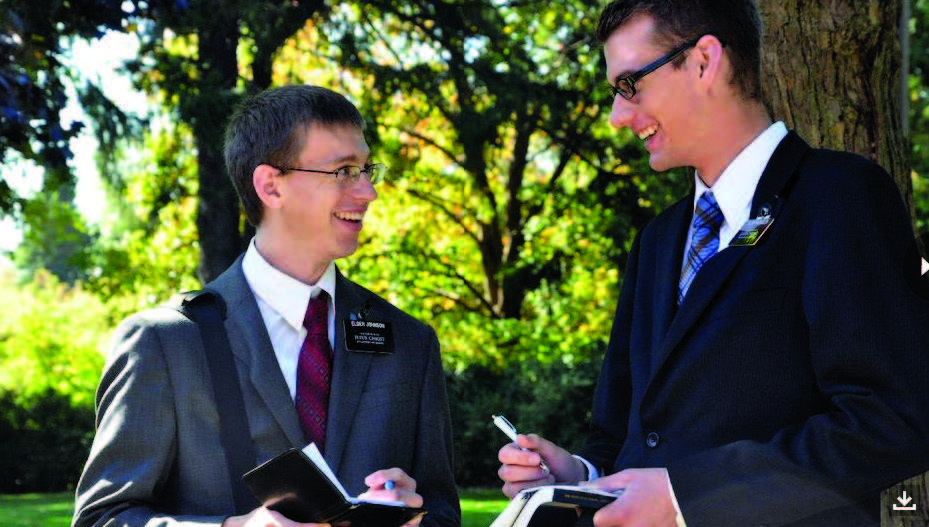
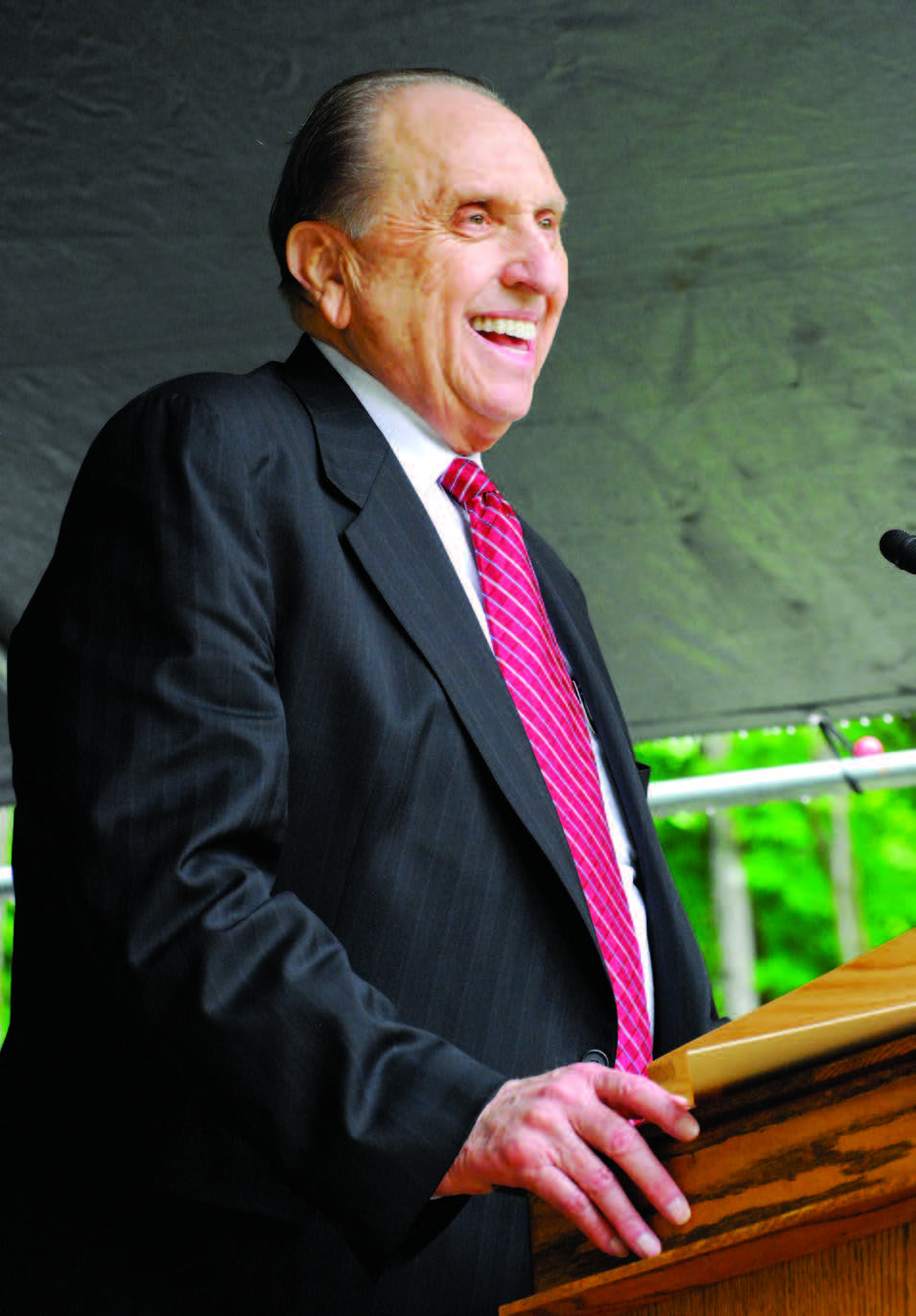
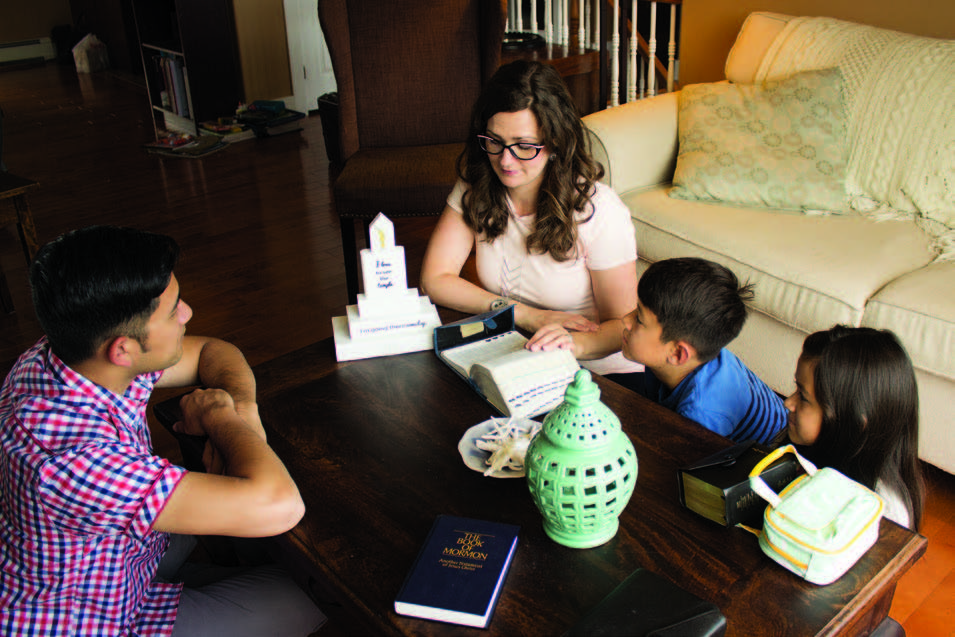
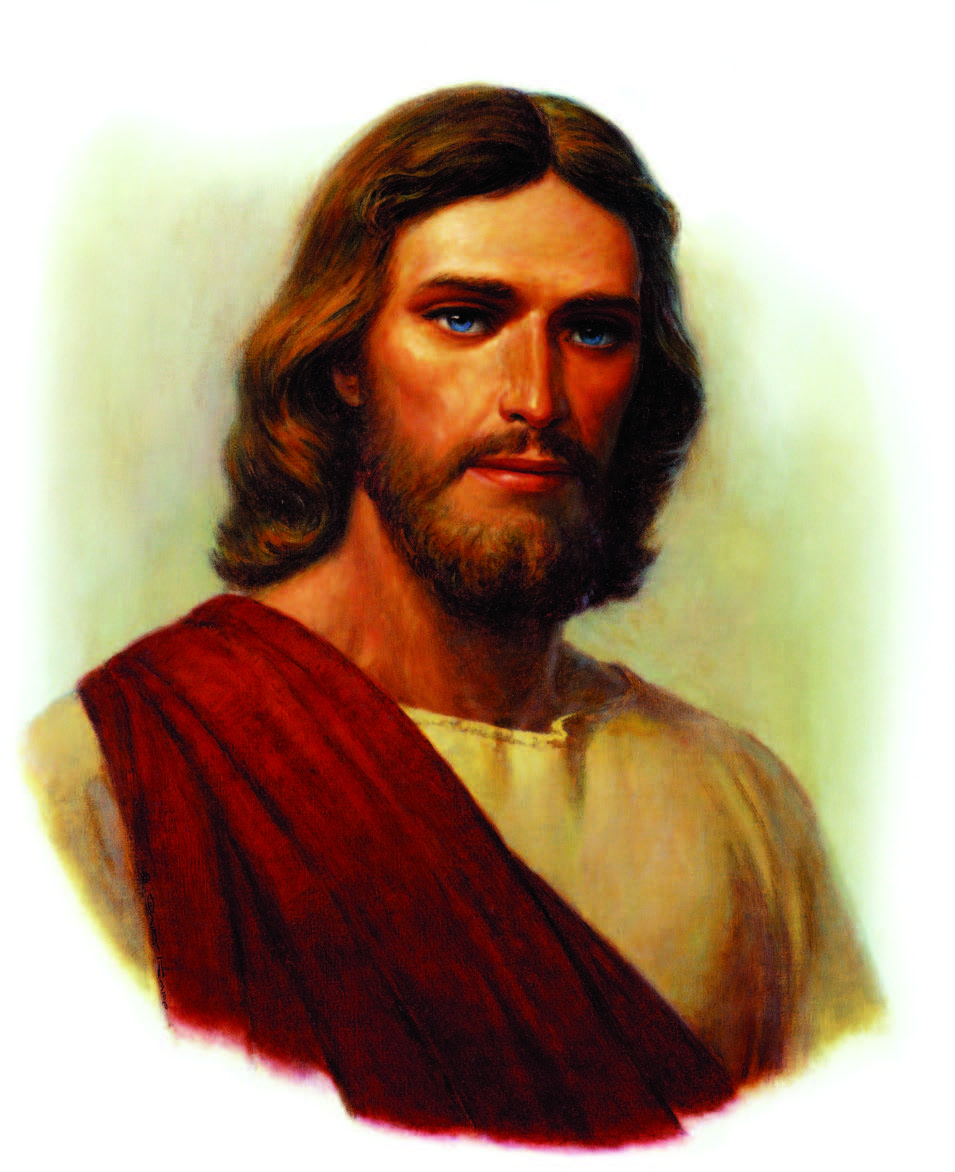
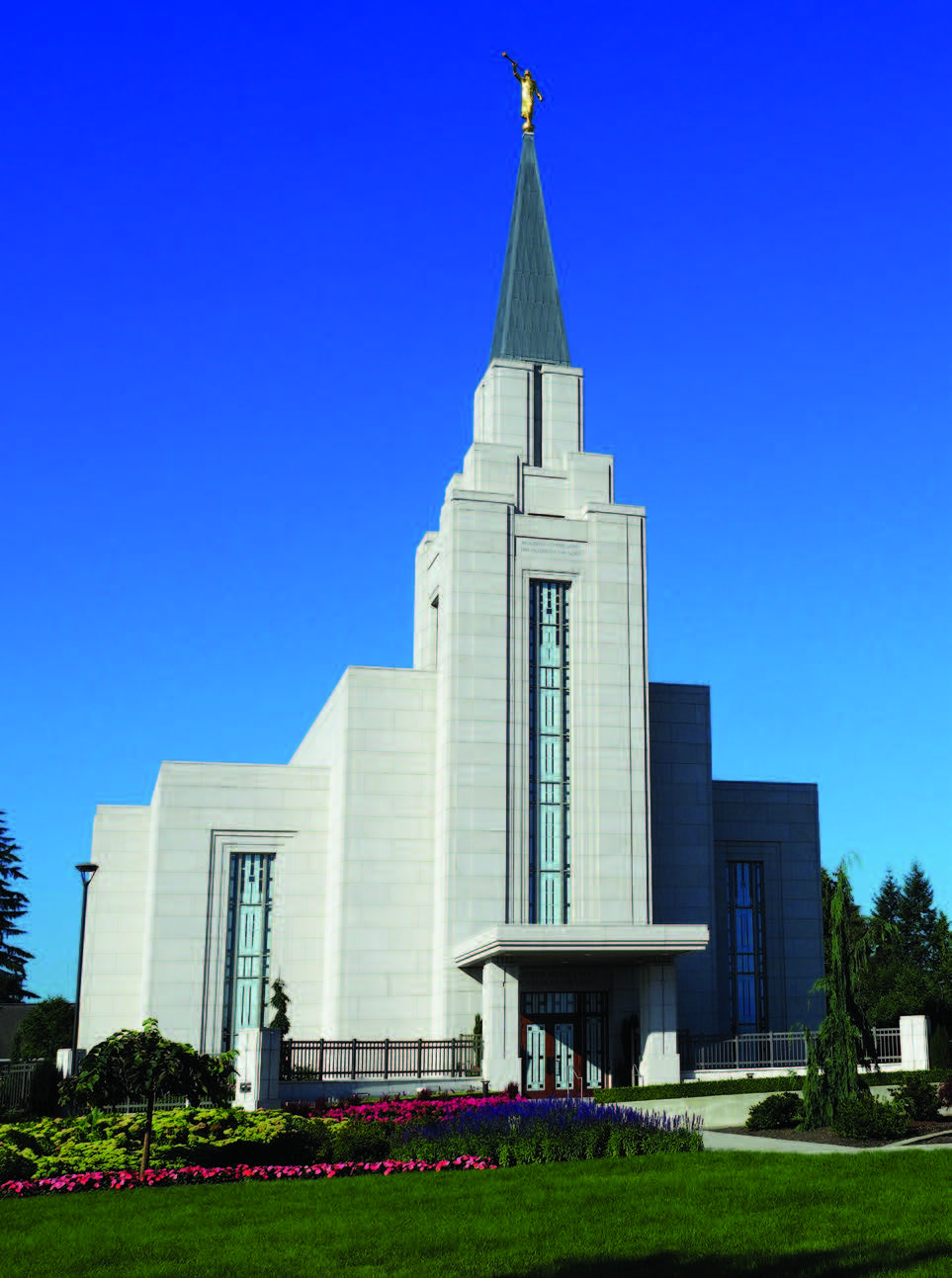
Notes
[1] Thomas S. Monson, “In Search of Treasure,” April 2003 general conference, at https://
[2] Dean Perkins, Members and Statistical Records Division, The Church of Jesus Christ of Latter-day Saints, email to Stephen V. Beck, Country Profile Manager, Church History Library, 28 March 2016. Church membership in Alberta at the end of 1965 was 25,355 and 47,945 in Canada. At the end of 2015, Alberta Church membership stood at 80,710 and 193,850 for Canada. (Ibid.)
